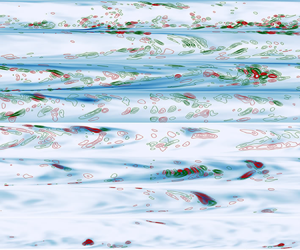Article contents
Repicturing viscoelastic drag-reducing turbulence by introducing dynamics of elasto-inertial turbulence
Published online by Cambridge University Press: 11 April 2022
Abstract

Recently, the nature of viscoelastic drag-reducing turbulence (DRT), especially the maximum drag reduction (MDR) state, has become a focus of controversy. It has long been regarded as polymer-modulated inertial turbulence (IT), but is challenged by the newly proposed concept of elasto-inertial turbulence (EIT). This study is to repicture DRT in parallel plane channels by introducing dynamics of EIT through statistical, structural and budget analysis for a series of flow regimes from the onset of drag reduction to EIT. Some underlying mechanistic links between DRT and EIT are revealed. Energy conversion between velocity fluctuations and polymers as well as pressure redistribution effects are of particular concern, based on which a new energy self-sustaining process (SSP) of DRT is repictured. The numerical results indicate that at low Reynolds number ( $Re$), weak IT flow is replaced by a laminar regime before the barrier of EIT dynamics is established with the increase of elasticity, whereas, at moderate
$Re$), weak IT flow is replaced by a laminar regime before the barrier of EIT dynamics is established with the increase of elasticity, whereas, at moderate  $Re$, EIT-related SSP can get involved and survive from being relaminarized. This further explains the reason why relaminarization phenomenon is observed for low
$Re$, EIT-related SSP can get involved and survive from being relaminarized. This further explains the reason why relaminarization phenomenon is observed for low  $Re$ while the flow directly enters MDR and EIT at moderate
$Re$ while the flow directly enters MDR and EIT at moderate  $Re$. Moreover, with the proposed energy picture, the newly discovered phenomenon that streamwise velocity fluctuations lag behind those in the wall-normal direction can be well explained. The repictured SSP certainly justifies the conjecture that IT nature is gradually replaced by that of EIT in DRT with the increase of elasticity.
$Re$. Moreover, with the proposed energy picture, the newly discovered phenomenon that streamwise velocity fluctuations lag behind those in the wall-normal direction can be well explained. The repictured SSP certainly justifies the conjecture that IT nature is gradually replaced by that of EIT in DRT with the increase of elasticity.
Information
- Type
- JFM Papers
- Information
- Copyright
- © The Author(s), 2022. Published by Cambridge University Press
References
REFERENCES
- 12
- Cited by


